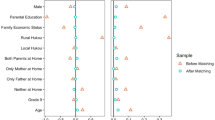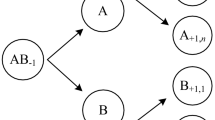Abstract
This paper uses the 1910 Census Public Use Sample to examine how the presence and activities of key family members shaped the labor force activity, domestic work, and schooling of working-age daughters. There is no evidence that daughters worked to send their brothers to school; parents practiced a more egalitarian distribution of resources than the literature suggests. Having brothers and sisters in school increased a daughter’s odds of attending school herself. Similarly, daughters with employed siblings were more likely to be gainfully employed. Nonetheless, parents allocated activities to sons and daughters in ways that reinforced traditional gender roles. Working brothers increase daughters’ likelihood of working in the home, while reducing their odds of attending school.
Similar content being viewed by others
References
Antin, M. [1912] 1969. The Promised Land. Boston: Houghton Mifflin.
Berk, S.F. 1985. The Gender Factory. New York: Plenum.
Bianchi, S.M. and D. Spain. 1986. American Women in Transition. New York: Russell Sage.
Brinton, M.C. 1988. “The Social-Institutional Bases of Gender Stratification: Japan as an Illustrative Case.” American Journal of Sociology 94:300–34.
Ciancanelli, P. 1983. “Women’s Transition to Wage Labor: A Critique of Labor Force Statistics and Reestimation of the Labor Force Participation of Married Women in the United States, 1900–1930.” Doctoral dissertation, New School for Social Research.
Cohen, M. 1982. “Changing Educational Strategies among Immigrant Generations: New York Italians in Comparative Perspective.” Journal of Social History 15:443–66.
Degler, Carl N. 1980. At Odds: Women and the Family in America from the Revolution to the Present. NewYork: Oxford University.
Ewen, E. 1985. Immigrant Women in the Land of Dollars: Life and Culture on the Lower East Side, 1890–1925. New York: Monthly Review Press.
Gershuny, J. and J.P. Robinson. 1988. “Historical Changes in the Household Division of Labor.” Demography 25:537–52.
Glenn, S.A. 1990. Daughters of the Shtetl: Life and Labor in the Immigrant Generation. Ithaca: Cornell University Press.
Goldin, C. 1981. “Family Strategies and the Family Economy in the Late Nineteenth Century: The Role of Secondary Workers.” Pp. 277–310 in Philadelphia: Work, Space, Family, and Group Experience in the 19th Century, edited by T. Hershberg. New York: Oxford University Press.
— 1989. “Life-Cycle Labor-Force Participation of Married Women: Historical Evidence and Implications.” Journal of Labor Economics 7:20–47.
— 1990. Understanding the Gender Gap: An Economic History of American Women. New York: Oxford University Press.
Greenhalgh, S. 1985. “Sexual Stratification: The Other Side of ‘Growth with Equity’ in East Asia.” Population and Development Review 11:265–314.
Guest, A. and S.E. Tolnay. 1983. “Children’s Roles in Fertility.” Social Science History 7:355–80.
Guo, G. 1993. “Use of Sibling Data to Estimate Family Mortality Effects in Guatemala.” Demography 30:15–32.
Haines, M. 1979. “Industrial Work and the Family Life Cycle.” Research in Economic History 4:289–356.
— 1981. “Poverty, Economic Stress, and the Family in a Late Nineteenth-Century American City: Whites in Philadelphia, 1880.” Pp. 240–76 in Philadelphia: Work, Space, Family, and Group Experience in the 19th Century, edited by T. Hershberg. New York: Oxford University Press.
Hareven, T. 1982. Family Time and Industrial Time. Cambridge, UK: Cambridge University Press.
Hartmann, H. 1981. “The Family as the Locus of Gender, Class and Political Struggle: The Example of Housework.” Signs 6:366–94.
Hochschild, A. with A. Machung. 1989. The Second Shift: Working Parents and the Revolution at Home. New York: Viking.
Horan, P.M. and P.H. Hargis. 1991. “Children’s Work and Schooling in the Late Nineteenth-Century Family Economy.” American Sociological Review 56:583–96.
Jacobs, J.A. and M.E. Greene. 1994. “Race and Ethnicity, Social Class and Schooling in 1910.” Pp. 209–56 in After Ellis Island, edited by S. Watkins. New York: Russell Sage.
Jaffe, A.J. 1956. “Trends in the Participation of Women in the Working Force.” Monthly Labor Review 79:559–65.
Lamphere, L. 1987. From Working Daughters to Working Mothers: Immigrant Women in a New England Industrial Community. Ithaca: Cornell University Press.
Lieberson, S. 1980. A Piece of the Pie: Blacks and White Immigrants since 1880. Berkeley: University of California Press.
Maddala, G.S. 1983. Limited-Dependent and Qualitative Variables in Econometrics. Cambridge, UK: Cambridge University Press.
Modell, 1. 1978. “Patterns of Consumption, Acculturation, and Family Income Strategies in Late Nineteenth-Century America.” Pp. 206–40 in Family and Population in Nineteenth Century America, edited by T.K. Hareven and M.A. Vinovskis. Princeton: Princeton University Press.
Odencrantz, L.C. 1919. Italian Women in Industry: A Study of Conditions in New York City. New York: Russell Sage.
Oppenheimer, V.K. 1970. The Female Labor Force Participation in the United States: Demographic and Economic Factors Governing Its Growth and Changing Composition. Berkeley: Institute of International Studies.
Parsons, D.O. and C. Goldin. 1989. “Parental Altruism and Self-Interest: Child Labor among Late Nineteenth-Century American Families.” Economic Inquiry 27:637–59.
Peiss, K. 1986. Cheap Amusements: Working Women and Leisure in Turn-of-the-Century New York. Philadelphia: Temple University Press.
Perlmann, J. 1988. Ethnic Differences: Schooling and Social Structure among the Irish, Italians, Jews, and Blacks in an American City, 1880–1935. New York: Cambridge University Press.
Pienta, A.M., J.A. Burr, and J.E. Mutchler. 1994. “Women’s Labor Force Participation in Later Life: The Effects of Early Work and Family Experiences.” Journal of Gerontology 49:S231–39.
Pleck, E.H. 1978. “A Mother’s Wages: Income Earning among Married Italian and Black Women, 1896–1911.” Pp. 490–510 in The American Family in Social-Historical Perspective, 2nd ed., edited by M. Gordon. New York: St. Martin’s.
Rosenzweig, M.R. 1982. “Wage Structure and Sex-Based Wage Inequality: The Family as Intermediary.” Population and Development Review 8 (Supplement):192–206.
Rubin, L. 1976. Worlds of Pain: Life in the Working-Class Family. New York: Basic Books.
Ryan, M. 1981. Cradle of the Middle Class: The Family in Oneida County, New York, 1790–1865. Cambridge, UK: Cambridge University Press.
Sassier, S. 1991. “The Context of Women’s Labor Force Participation: Household and Ethnic Factors in New York City in 1910.” Presented at the annual meetings of the American Sociological Association, Cincinnati.
Smith, D.S. 1994. “A Higher Quality of Life for Whom? Mouths to Feed and Clothes to Wear in the Families of Late Nineteenth Century American Workers.” Journal of Family History 19:1–33.
Smith, J.E. 1985. Family Connections: A History of Italian and Jewish Immigrant Lives in Providence, Rhode Island, 1900–1940. Albany: SUNY Press.
Smuts, R.W. 1960. “The Female Labor Force: A Case Study in the Interpretation of Historical Statistics.” Journal of the American Statistical Association 55:71–79.
South, S.J. and G. Spitze. 1994. “Housework in Marital and Nonmarital Households.” American Sociological Review 59:327–47.
Strong, M., S.H. Preston, A.R. Miller, M. Hereward, H.R. Lentzner, J.R. Seaman, and H.C. Williams. 1989. User’s Guide: Public Use Sample, 1910 United States Census of Population. Philadelphia: University of Pennsylvania, Population Studies Center.
Tender, L.W. 1979. Wage-Earning Women: Industrial Work and Family Life in the United States, 1900–1930. New York: Oxford University Press.
Tilly, L.A. and J. Scott. 1978. Women, Work, and Family. New York: Holt, Rinehart and Winston.
U.S. Bureau of Labor. 1910. “Wage Earning Women in Stores and Factories.” Report on Conditions of Woman and Child Wage-Earners in the United States, Vol. 5:368, 652-55, Table 13. Washington, DC.
Waite, L.J., F.K. Goldscheider, and C. Witsberger. 1986. “Nonfamily Living and the Erosion of Traditional Family Orientations among Young Adults.” American Sociological Review 51:541–54.
Walters, P.B. and C.M. Briggs. 1993. “Child Labor and Schooling in the Early Twentieth-Century South.” American Sociological Review 58:163–81.
Weinberg, S.S. 1988. The World of Our Mothers: The Lives of Jewish Immigrant Women. New York: Schocken.
Weiner, L.Y. 1985. From Working Girl to Working Mother: The Female Labor Force in the United States. 1820–1920. New York: Schocken.
Zunz, O. 1982. The Changing Face of Inequality: Urbanization. Industrial Development. and Immigrants in Detroit. 1880–1920. Chicago: University of Chicago Press.
Author information
Authors and Affiliations
Additional information
This research was supported by NICHD Training Grant HD07338-05 from the Population Studies and Training Center at Brown University and by NIA Grant T32-AG00237 from the Department of Population Dynamics at Johns Hopkins University. An earlier version of this paper was presented at the 1994 annual meetings of the Population Association of America, held in Miami. I thank Ann Biddlecom, Calvin Goldscheider, Felicia LeClere, Bill Marton, Bob Schoen, Michael J. White, two anonymous reviewers, and both Avery Guest and Frances Goldscheider for their encouraging and constructive suggestions.
Rights and permissions
About this article
Cite this article
Sassler, S. Trade-offs in the family: Sibling effects on daughters’ activities in 1910. Demography 32, 557–575 (1995). https://doi.org/10.2307/2061675
Issue Date:
DOI: https://doi.org/10.2307/2061675




